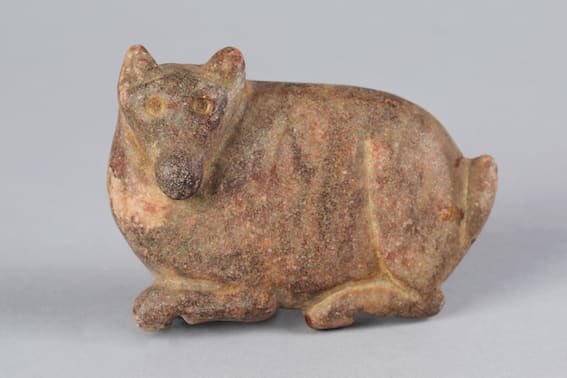Sumerian period stone figurine of a fox
Although representations of animals in paint and small-scale sculpture does occur in the Mesopotamian region as early 40,000 BC, it is during the Neolithic period, from around 10,000 BC, and...
Although representations of animals in paint and small-scale sculpture does occur in the Mesopotamian region as early 40,000 BC, it is during the Neolithic period, from around 10,000 BC, and at places like Gobekli Tepe in south-eastern Turkey, that carved animals in very high relief are being introduced and associated with monumental architecture intended to create sacred spaces.
This was also the era in which the transition from hunting to herding and to permanent agricultural villages took place. The rich symbolism of wild creatures, which had probably long been linked with the supernatural world, now incorporated domesticated animals. By around 4500 BC stone stamp seals engraved with abstract designs of animals were being impressed on lumps of wet clay or plaster; these were placed on the fastening of baskets, ceramics, sacks, and storeroom doors to define individual property and to secure, perhaps magically through the power of the animals depicted, the containers and rooms against unauthorised opening. The relationship between humans and animals at a supernatural level had become entwined in art; originating in the mountains of Iran, this tradition would have a profound influence on Mesopotamian beliefs and representation for thousands of years. It is, however, the centuries around 3300 BC that are the starting point for exploring further Mesopotamian sculpted animals. The world’s earliest states and cities emerged in this period and with them some of the most accomplished representations of animals that have survived from the ancient world. In the far south of Mesopotamia, at the head of the Persian Gulf, lay the city of Uruk, which by this date was home to tens of thousands of people, sustained by fields of grain and vast herds of cattle and flocks of sheep. Here mud-brick temple buildings were constructed on a monumental scale. Associated with this architecture were sculptures of animals in both clay and stone, representing cattle and sheep, and the lions that threatened them. The skill to imitate the natural form of living animals is very evident in many of the carvings. Objects in the form of animals and many of the stone figurines, which are often inlaid with precious stones and metals from the highlands of Iran or further afield, were probably intended as votive offerings.
This was also the era in which the transition from hunting to herding and to permanent agricultural villages took place. The rich symbolism of wild creatures, which had probably long been linked with the supernatural world, now incorporated domesticated animals. By around 4500 BC stone stamp seals engraved with abstract designs of animals were being impressed on lumps of wet clay or plaster; these were placed on the fastening of baskets, ceramics, sacks, and storeroom doors to define individual property and to secure, perhaps magically through the power of the animals depicted, the containers and rooms against unauthorised opening. The relationship between humans and animals at a supernatural level had become entwined in art; originating in the mountains of Iran, this tradition would have a profound influence on Mesopotamian beliefs and representation for thousands of years. It is, however, the centuries around 3300 BC that are the starting point for exploring further Mesopotamian sculpted animals. The world’s earliest states and cities emerged in this period and with them some of the most accomplished representations of animals that have survived from the ancient world. In the far south of Mesopotamia, at the head of the Persian Gulf, lay the city of Uruk, which by this date was home to tens of thousands of people, sustained by fields of grain and vast herds of cattle and flocks of sheep. Here mud-brick temple buildings were constructed on a monumental scale. Associated with this architecture were sculptures of animals in both clay and stone, representing cattle and sheep, and the lions that threatened them. The skill to imitate the natural form of living animals is very evident in many of the carvings. Objects in the form of animals and many of the stone figurines, which are often inlaid with precious stones and metals from the highlands of Iran or further afield, were probably intended as votive offerings.



